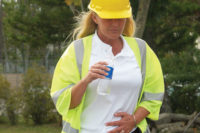
With summer around the corner, it’s time to start preparing for the hot days ahead and how they affect employees. Difficult, strenuous work conditions can impact the health and well-being of your employees anytime. When the ambient temperature combines with humidity and work load, it drastically affects the body’s ability to cool itself. This can cause physical and mental fatigue, heat cramps, heat exhaustion and life-threatening heat stroke.
Basic industrial hygiene calculation gives us excellent rules of thumb for calculating the heat stress on an employee. These calculations take into consideration environmental factors such as temperature and humidity, ventilation and time. Radiant and convection heat are also calculated into the equation. While these formulas provide good parameters in which to keep your employees safe from heat overload, the question remains: “How long can the employee work safely in such conditions?”
There are numerous factors that play into a person’s tolerance for heat stress, many of which are not part of the textbook formula for employee exposure. Besides all the obvious factors mentioned above, the employee’s health, current hydration levels, overall health and acclimation all play important roles in assessing an employee’s ability to safely work under heat stress conditions.
The right beverage
So while a broad approach is required to protect employees, one important element of heat stress protection is picking the right thirst quencher. Before doing that, however, there are some factors to consider. The same drink supplied to one employee may be detrimental to another. For example, an employee needing a drink that will replenish his body’s salt levels might do well with a high-sodium beverage, whereas an employee working in the same area who has high blood pressure would not want to consume large amounts of a high-salt drink. Similarly, a diabetic employee would not want a drink with high levels of sugar.The industrial hygiene calculation mentioned above must stand as your baseline for making decisions concerning heat stress exposure. The ACGIH® Threshold Limit Values (TLVs®) and Biological Exposure Indices (BEIs®) handbook is an excellent reference for thermal stress information and guidelines. Once you’ve done your homework, you come back to a very fundamental focus of how best to keep employees properly hydrated. The obvious answer may seem to be “just have them drink more water.” But you have to dig a little deeper into what’s happening in the body before making a snap judgment.
Keeping hydrated
The natural choice for hydration is water. It hydrates better than any other liquid, both before and during exercise or work activity. Water is obviously less expensive than thirst drinks. You need to drink 12-16 ounces of water for every hour of work, and more in extreme heat stress situations. That can add up to a lot of water! Drinking that much water becomes burdensome, and the water becomes bland. Many find it hard to continue aggressive hydration. This is where thirst quenchers can help.To maintain comfort and health when working in a hot environment, people need to replace both the water and electrolytes they lose through sweating. Electrolytes increase the efficiency of the body’s cooling mechanisms. Both muscle tissue and neurons are considered electric tissues of the body. Muscles and neurons are activated by electrolyte activity.
For example, muscle contraction is dependent upon the presence of calcium (Ca2+), sodium (Na+) and potassium (K+). Without sufficient levels of these key electrolytes, muscle weakness or severe muscle contractions or cramps may occur. Electrolytes are important because they are what your cells (especially nerve, heart, muscle) use to maintain proper electrical balances in the body. For example, when you exercise heavily or work in a heat stress environment, you lose electrolytes in your sweat, particularly sodium and potassium. These electrolytes must be replaced to keep the electrolyte concentrations of your body fluids constant. So, many thirst quenchers have sodium chloride or potassium chloride added to them. They also have sugar and flavorings to provide your body with extra energy and to make the drink taste better.
Thirst quenchers
Sometimes called sports drinks, thirst quenchers don’t hydrate better than water, but you are more likely to drink larger volumes, which leads to better hydration. Thirst quenchers are designed to maximize fluid absorption and enhance performance by delivering carbohydrates and electrolytes, the most crucial of which is sodium. Thirst quenchers typically contain more than one type of carbohydrate. Check the ingredient list and you’ll find a combination of simple carbohydrates (sucrose, glucose and fructose) and complex carbohydrates, such as glucose polymers and maltodextrins. The better-formulated (and tasting) drinks usually contain both, with a higher percentage of complex than simple carbohydrates. (Labels list ingredients by weight from most to least.)Numerous studies have found the optimum carbohydrate concentration of well-absorbed and tolerated thirst quenchers to be 4-8%. Some drinks that contain 0% complex carbohydrates use 100% sugars. So, if complex carbohydrates are preferred, then why do the majority of leading sports drinks use so much sugar? The answer is quite simple — taste. Simple sugars are sweet and add flavor to the product. Complex carbohydrates on the other hand tend to be bland tasting in comparison. Sweeter drinks appeal to more people.
To choose the right thirst quenchers for your workers you must evaluate the levels of heat stress, the condition of your employees, and the actual amount of hydration you are going to be able to achieve. Ultimately, your best hydration strategy is going to be a well-planned mix between plenty of water and just the right amount of a thirst quencher that meets your electrolyte and carbohydrate needs.






